A replica of German Crampton no. 28 ‘Die Pfalz’ at Nurnberg on 8/9/1963
Photo Les Perkins
Although the first steam locomotive in France was built in Britain by Robert
Stephenson & Co. in 1828 for trials by the Cie. St. Etienne À Lyon and locomotives built
to the designs of Thomas Crampton achieved some success, particularly on the CF du Nord.
the vast majority of locomotives built for use in France including the Cramptons were
constructed by the indigenous manufacturers who were also the fourth largest builders
of locomotives behind those of the USA, Germany & Britain.
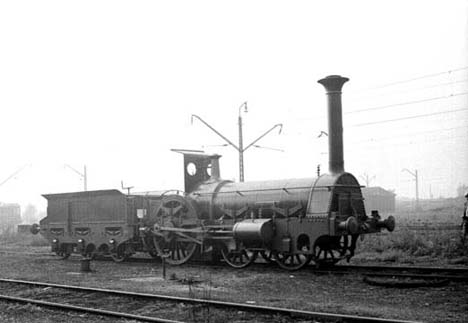
120 Cramptons were built between 1849 & 1860 for the 3 companies that used them with just under half going to the Nord who first ordered them. Here they lasted in passenger service for over 30 years until the growing train weights exceeded their adhesion & steaming capacities. The PLM used them for the least time due to the generally more mountainous nature of their system and having sold 11 to the CF de l’Est in 1869 they had withdrawn or sold the remainder by 1880. Those already supplied new to the Est along with those purchased from the PLM had the longest working lives with most achieving around 50 years service. Number 80 ‘Le Continent’ built for the CF Paris - Strasbourg by Cail in 1852 survives to this day, having been renovated at Epernay Works in 1924 for excursion use and is now located in Mulhouse museum.
The Crampton Locomotive, was not very well-known in Britain or America, but was a great success in France and Germany. It was created by Thomas Crampton, an Englishman, and the first example was built at Whitehaven for Belgium in 1846. The key element of the design was the placing of the single driving axle behind the firebox, enabling large driving wheels to co-exist with a large low-placed boiler. In the long term, this solution seems less important than Crampton's adoption of wide steam passages, generous bearing surfaces, and large heating surfaces, and it was these three features rather than the position of the driving axle that ensured the high-speed qualities of his locomotives. source www.steamindex.com
The latter characteristics were among the features developed on by French Engineers culminating in the world famous rebuild work undertaken on the Paris-Orleans pacifics by that railway’s Chief Mechanical Engineer at the time M André Chapelon, arguably the world’s best steam locomotive designer at least up until the demise of steam in Western Europe.
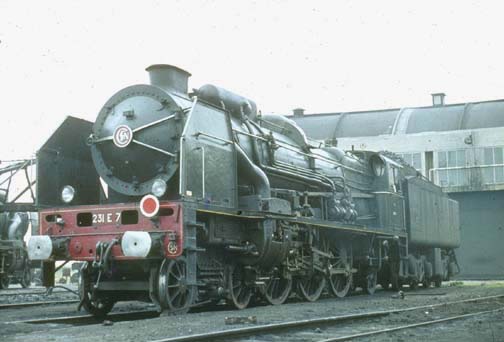
One of these pacifics is seen in the shed yard at Calais, built for
the PO by Cail in 1914, rebuilt in 1934 and sold to the CF du Nord soon afterwards as a result of the
Paris to Brive electrification.
Photo : Paul Riley
Stepping back to the nineteenth century some drawings are shown below of French
built locomotives taken from a book on locomotive engineering published in 1871 which
had been the personal property of a member of staff in the drawing office of Beyer
Peacock & Company in Manchester. These mainly depict experimental types but the Engerth
goods engine pictured below was one of 40 of this type that served the Nord for over 40
years. This was one of the 2nd batch of ten engines built by Graffenstaden in 1857, the
first 30 having been built by Schneider & Cie. in 1855.
Below the next drawing also depicts the first of a class of 20 Duplex 0-6-6-0 tanks built to the design of Jules Petiet the Nord's Locomotive Engineer by Etablissement Gouin in Paris, this one in 1863 along with 9 others. These were not successful and were rebuilt into 40 ‘Orleans’ type 0-6-0Ts for station pilot work at the company’s works at La Chappelle between 1872 & 1874. For further information on Petiet’s experimental designs check out the Douglas Self site
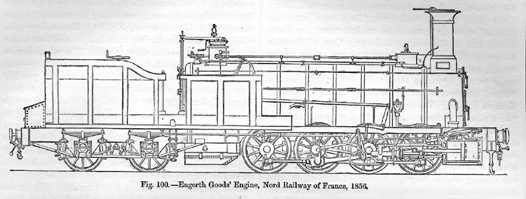
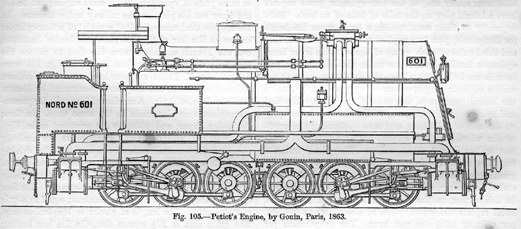
‘L’Aigle’ shown below was an experimental locomotive designed by M Aimé-Etienne Blavier and M Larpent for the CF de L'Ouest, built by Gouin in 1855 and exhibited at the Paris Exhibition that year. She had the largest diameter driving wheels ever fitted to a French locomotive at 2.85 metres (9’ 4”) but the restricted boiler size resulting from this being slung beneath the axles limited her potential for high speed running that the wheel diameter was intended to allow. She carried the number 261, was modified in 1858 and was not withdrawn until 1875. Details regarding this can also be seen on the Douglas Self site (link above)
The final drawing below depicts one of a pair of 0-8-0s designed by M Beugniot of André Koechlin & Cie. at Mulhouse who built them in 1859/60 for use on the PLM’s more mountainous lines in the Alps and the Cevennes. The design was a derivative of the Engerth type with the rear of the cab mounted over the leading axle of the tender that projected forward beyond its body to transfer some of the tender weight onto the engine. Trials were run with these in various places but they proved to be too complex and difficult to maintain and both were eventually withdrawn in 1886?.
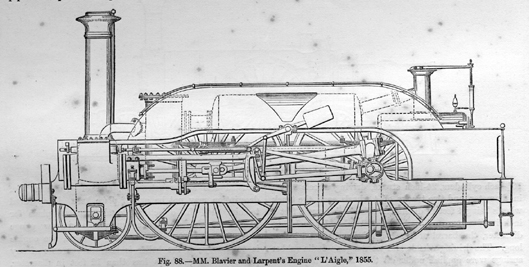
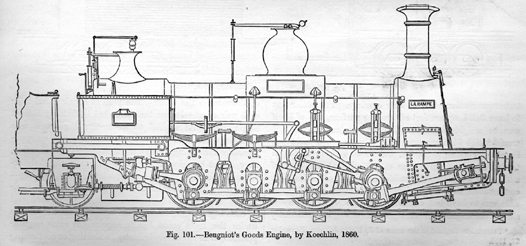
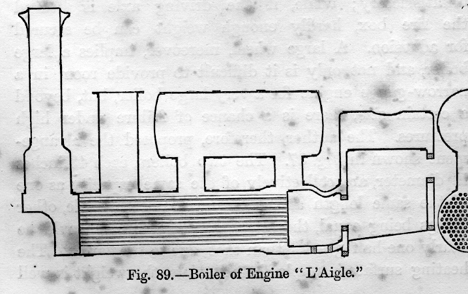
A major feature in the development of French locomotive design was the application of compounding principles, the re-use of exhaust steam from the high pressure cylinder in a low pressure one making greater use of the expansive nature of steam resulting in greater fuel economy. The theory was first converted into practice in France by Anatole Mallet when he modified 2 0-4-2 tanks owned by the CF de Bayonne a Biarritz in 1876 with the two simple expansion cylinders being replaced by a high pressure one on one side and a low pressure one on the other. The idea did not immediately catch on at home in France and for nearly a decade it was left to Von Borries in Germany & Webb in England to develop main line compound locomotives. The next compound locomotive in France was a Webb type 3 cylinder machine purchased for trials from Sharp Stewart in Manchester by the CF de l’Ouest in 1884 . This did not prove successful in that the economy achieved was only 10% as opposed to the 16% claimed by Webb and its speed in traffic did not match that being achieved by the company’s simple expansion engines. So the baton then passed to the Nord.
In 1885 Société Alsacienne de Construction Mécaniques (SACM) built the first 4 cylinder compound in France for the Nord jointly designed by the manufacturer’s chief engineer, English born Alfred de Glehn, and Gaston du Busquet then head of the Nord’s works at Hellemmes. This was 2-2-2-2 number 701 with the two pairs of drivers not coupled and the two outside high pressure driving the front pair and the two inside low pressure cylinders driving the rear pair. This prototype was rebuilt as a 4-2-2-2 and survived in this form so that she is now also on display in the museum at Mulhouse. Du Busquet became the Chief Engineer of the Nord in 1890 and the development of the compounds then proceeded apace with the first 4-4-0 produced in 1891 to the extent that by the time he was succeeded by Georges Asselin in 1910 the Nord had 112 compounds in service 52 4-4-0s, 35 4-4-2s & 25 4-6-0s, with a pair of experimental 4-6-4s on the drawing board. The PLM were only a couple of years behind the Nord in producing their first prototype 4 cylinder compound locomotives and 1910 had produced 160 production 4-4-0s, 20 4-4-2s, 297 0-8-0s, 135 4-6-0s and around 200 4-8-0s. The other French main line companies also acquired them in large numbers and with the economies & performances achieved from these types they soon came to the attention of the wider world.
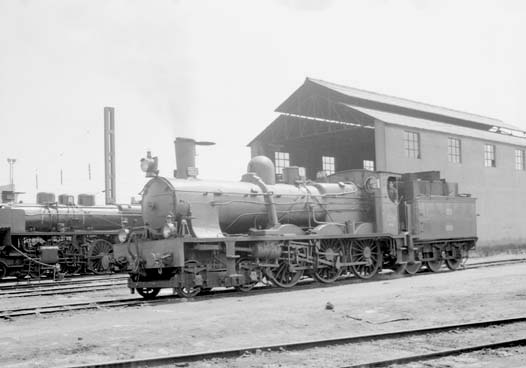
De Glehn du Busquet 4 cylinder compound 4-6-0 number 262, one of
a batch of 12 built by Fives-Lille between 1899 & 1904, stands in the shed yard at Entroncamento,
Portugal in May 1964. A member of this class was still in traffic on the CP in 1969
Photo : Les Perkins
Getting the maximum performance out of the compounds required both high levels of
skill on the part of the footplate staff & high standards of maintenance, factors that
became in increasingly short supply as steam was gradually phased out in favour of
diesel & electric traction. As a result in the final decade of steam operations in
France, it was the two cylinder simple expansion locomotive types that dominated the
remaining steam operated traffic, the vast majority of the locomotives remaining in
traffic being the 141R 2-8-2s imported from North America at the end of the World War ll.
Stepping back once more to the era of Jules Petiet as Chief Engineer of the CF du Nord, a tribute to him written by Dr John Davies in his locomotive list for the company refers to another development in locomotive design begun in France that was to have wide implications for the world at large for nearly a century and the paragraph is quoted in full below with its reference to the duplex number 601 illustrated above.
“Petiet died of apoplexy on 29/1/1871 and left the NORD with 841 locos. It seems clear that he was far ahead of his time. While he had a few failures, the steam drier was to develop into the modern superheater, the ‘duplex’ 0-6-6-0 into the Meyer and later Garratt (once the idea of articulation had been worked out) and large grates and large steam passages later became the norm for efficient locomotives. Moreover, his early use of the Belpaire firebox predated its general use on the Etat Belge by its own inventor, who was Chief Engineer of that line.”
It was in 1889 that Anatole Mallet designed & built the first example of the locomotive type that was forever to bear his name, a machine with two engine units mounted under a single boiler with leading unit built on its own separate frame with a pivot upon which the front end of the boiler rested. After a few years gestation, ongoing development of the Mallet then basically took two different paths. In most of the world it was used on colonial & narrow gauge railways where operating conditions demanded a high power output from a machine combining a relatively low axle weight with the ability to negotiate sharp curves, something that a Mallet with many axles and a flexible wheelbase was ideal for. In many ways its development in this role was overtaken about 30 years later by the development of the Garratt which allowed a larger boiler to be used without prejudicing the axle weight & curvature restrictions. It was in the United States however that the development of the Mallet was to make the biggest impression on the public imagination with their development on to become the heaviest & most powerful locomotives ever built. Here they were developed to run on an existing system of main lines that were generally well aligned and had fairly generous existing axle load limits.
The picture above illustrates the first North American mallet built by Alco for the Baltimore & Ohio RR in 1904. In less than 40 years this had led on to the Challenger 4-6-6-4s & Big Boy 4-8-8-4s of the Union Pacific & the Allegheny 2-6-6-6s of the Chesapeake & Ohio. The Union Pacific locomotives could produce a fair turn of speed in addition to their brute haulage capacity and the Challengers were regularly used in passenger traffic. Many engineers from around the world contributed to the long process of the development of the steam locomotive which to a very limited extent is still going on in 2005 but it is hoped that the above will illustrate the full part played in this process by French Engineers both those mentioned & the many that have not been.
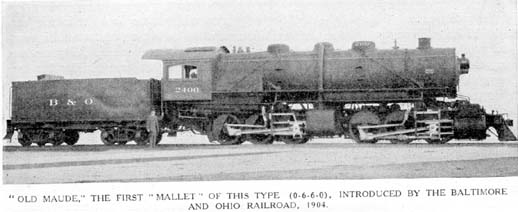
Wartime relocations
Another significant factor that impacted on the locomotive types in use in France were the two World Wars and right up to end of steam operations locomotives were in use that were in France as a result of both conflicts; either left behind by the occupying forces or constructed abroad as the result of the reduced capacity of French manufacturers to construct new locomotives. The North American built 141R 2-8-2s operated most of the traffic in the last few years as already mentioned and there were also a handful of class 140C 2-8-0s in use some of which had been built North British & Vulcan Foundry during and immediately after WW1.
One of these locomotives ex Etat class 140C 2-8-0 number 140C.318, built by North
British (21655/1917), stands in the yard at Caen shed. Over 200 of this type were built
in Britain between 1916 & 1919 due to a shortage of capacity in France with some
builders in territory occupied by the Germans & other French builders plants committed
to arms manufacture.
As territory was recaptured or reoccupied after the armistice some German locomotives
were left in French hands. Below for example this former Prussian T13 0-8-0T number 040.TF.14,
built by Union-Gißerei in Königsberg (2147/1914), standing in the shed yard at Le
Bourget was taken into stock by the Nord after the war.
Photo : Norman Glover
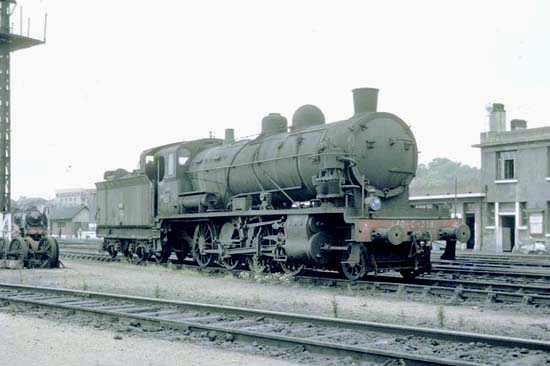
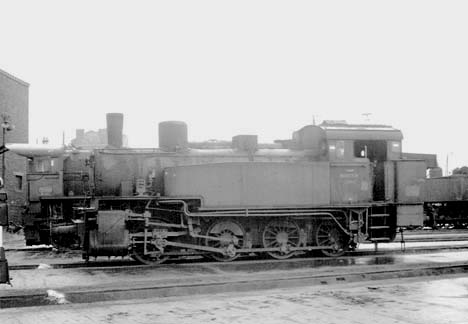
The Pershing type of 2-8-0 was built in large numbers for the US Army in France
between 1917 & 1919 with 242 being taken into Nord stock after the war. One of the these
is pictured below.
Photo left: Les Perkins
The second world war period produced a similar effect in its aftermath, the
absorption of a fair number of German & former US Army locomotives plus the post war
construction & supply of the 1323 141R 2-8-2 built to an SNCF specification. The
difference this time was that the process of reconstruction & modernisation was to
follow the electrification & dieselisation course and steam locomotives were needed
largely as a stop gap. As a result only about 300 compound locomotives were built from
1945 onwards and all of these had been withdrawn some 4 years before the last of the
141Rs.
‘Pershing’ 2-8-0 number 4.1472 (Baldwin 50914/1918) runs light through the station
at Pont Marcadet. This locomotive's final SNCF number was 140.G.1872 and she was
scrapped in 1952.
Photo : V R Webster
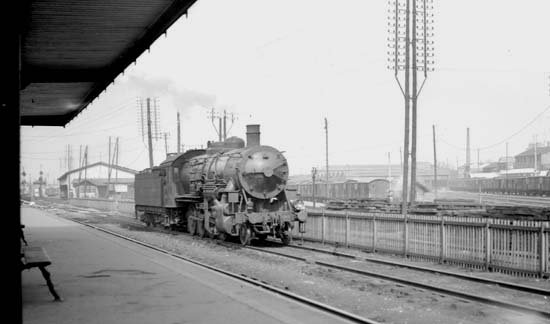
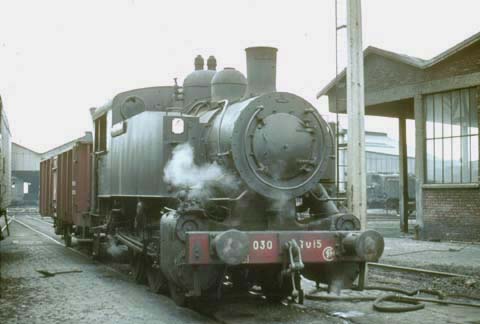
Former US Army Transportation Corps number 1308 built by Davenport (2479/1943),
class 030TU 0-6-0T number 030.TU.15 engaged on shed pilot duties at Calais.
Photo : Paul Riley
Pictured below & designed by the DRB War Committee as type KDL5, a smaller version of
the Prussian T16 class, 0-10-0T number 50TX.27, built by Cie. des Forges et Acieries
de la Marine & D'Homecourt at St Chamond (327/1945) stands in the yard at Caen shed on
2/8/1964.
Photo : Norman Glover
Of nearly 2000 Deutsche Reichsbahn class 44 2-10-0s built, 693 were
constructed by French locomotive builders during and immediately after the war, 226 of which
were taken into SNCF stock and numbered in the 150.X series along with 13 others that were used
still carrying their DRB numbers. Very few of these survived in service into the 1960s
and 48 were sold to Turkey in 1955 where they survived much longer.
Below : One of these 2-10-0s number 56743 built by Creusot (4777/1945) in France to the
DR class 44 design approaches Kardeşgediği, the junction of the lines to Konya &
Kayseri, with the 7.45am Adana to Istanbul train.
Photo : Tony Bowles
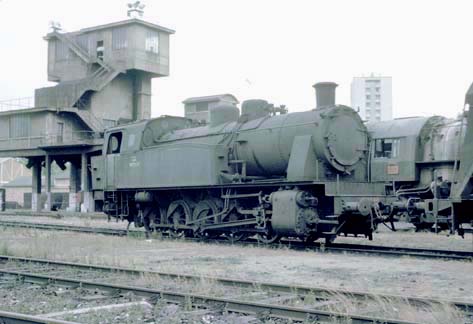
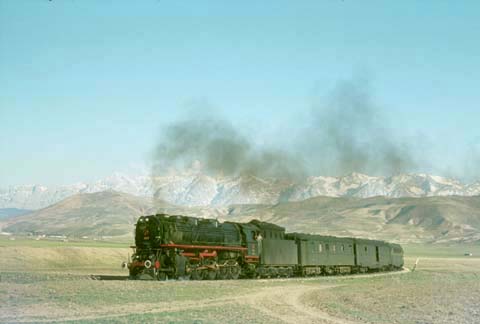
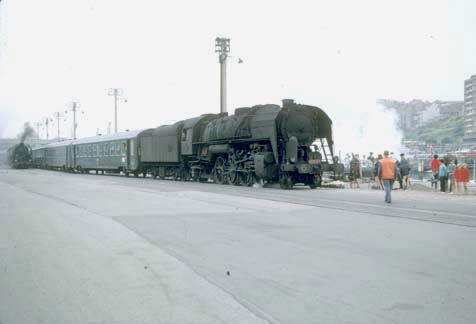
Finally above right is an example of a 141R 2-8-2 in service, a member of the class that
increasingly came to dominate steam powered operations in the period between the end of
WW2 and the the final elimination of steam traction. Here class 141R 2-8-2 number
141R 73 departs Boulogne Maritime with a boat train on 5th July 1970.
Photo : Norman Glover

